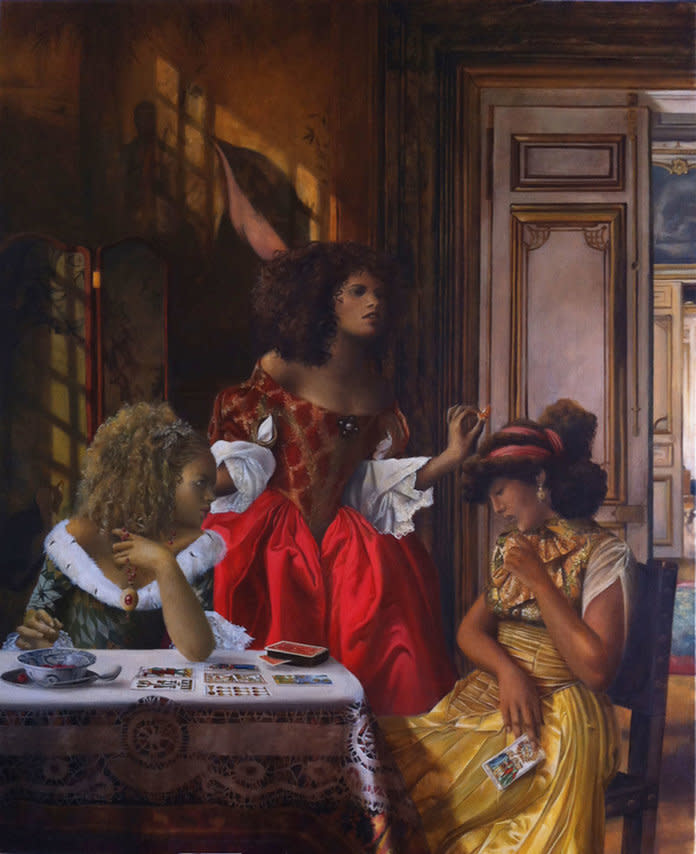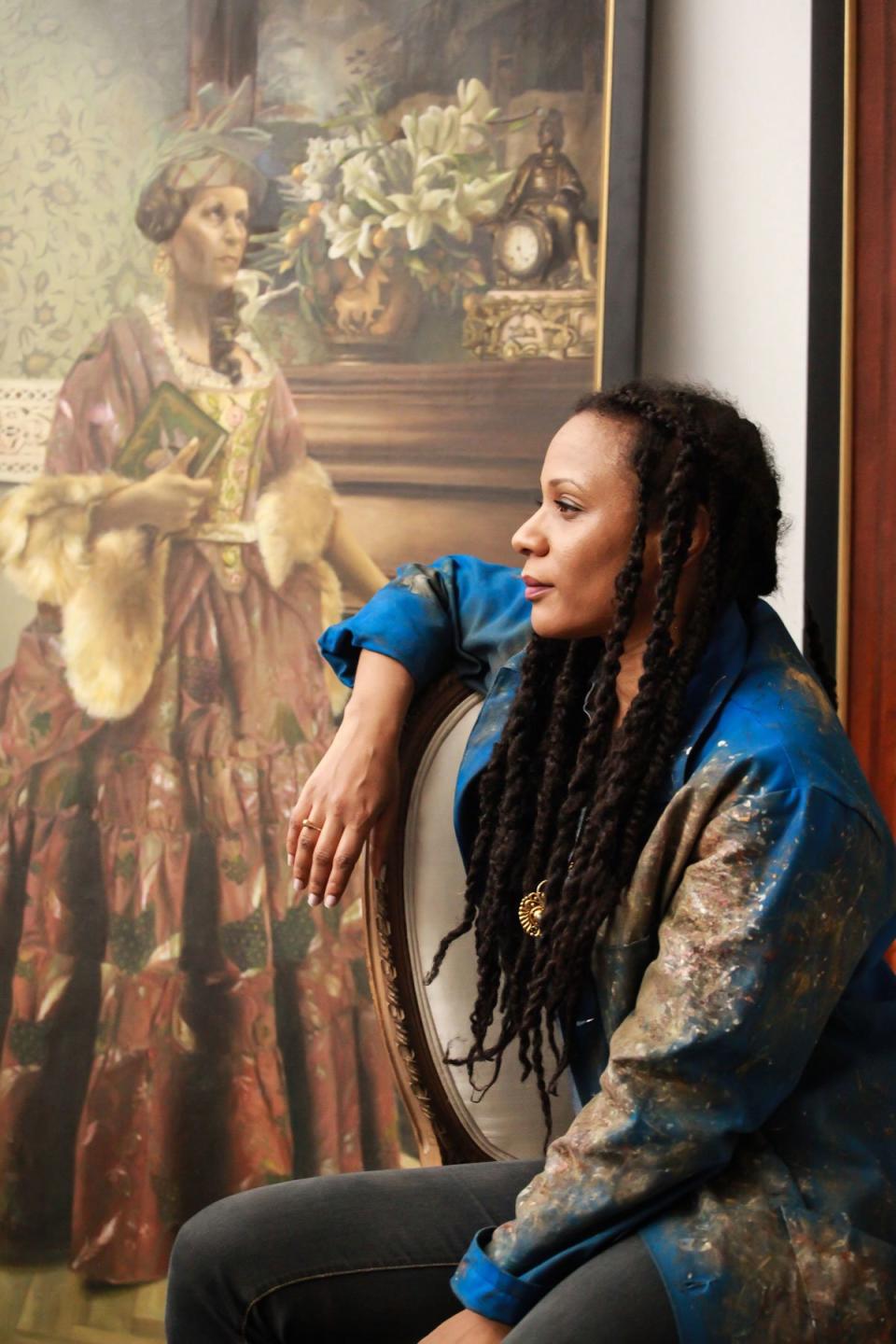Classically Trained Painter Elizabeth Colomba Paints the Women Art History Ignored
When you see the artwork of Harlem-based painter Elizabeth Colomba, it’s easy to mistake it for something created centuries ago; they’re the kinds of paintings you would find hanging in the Louvre or the Rijksmuseum. The quality of light, the colors, the rich texture of the subjects’ clothing, and the background bring to mind the works of Dutch Baroque painters like Johannes Vermeer — except Colomba’s paintings feature black women.
And unlike the handful of black women depicted throughout the history of Western art, these women are not servants or an ancillary to a white person; nor are they fetishized or exoticized. Her subjects are the focus of the paintings, and they are portrayed in lavish, affluent settings, like many of the European women painted by the old masters.
“While acknowledging the past, I wish to reshape the narratives and bend an association of ideas so that a black individual in a period setting is no longer synonymous with subservience and, by extension, does not instill fear or mistrust,” says Colomba in her artist’s statement. “The subject becomes the center of her own story and hastens it forward.”
Born to Martinican parents in Épinay-sur-Seine, just north of Paris, Colomba wanted to be an artist from a young age and displayed a natural talent as a child. She later studied art formally in Paris, at the École Estienne and the École nationale supérieure des Beaux-Arts. After graduating, she worked as a storyboard artist in Los Angeles and eventually moved to New York to focus on fine arts.
Now, Colomba is working on some new paintings that explore the relationship between the black figure and leisure. Influenced by Walton Ford’s large-scale watercolors, the series will consist of four watercolors and two oil paintings. For now, you can see one of her paintings in an exhibition marking 100 years of women’s suffrage, “She Persists: A Century of Women Artists in New York,” a group show at Gracie Mansion, the residence of New York City’s mayor. (The 19th Amendment, which grants women the right to vote, was sent to the states for ratification in 1919.) As New York City’s first lady, Chirlane McCray, remarked in an interview with The New York Times, most of the portraits in Gracie Mansion were of men, so her hope is that this exhibition will “fix that and show women who’ve been unheralded, unseen.”
RELATED: "This Is America" Choreographer Sherrie Silver Is Just Getting Started
Colomba was among the 50 women featured on InStyle’s most recent Badass 50 list. Here, her complete interview follows the image of her painting,The Reading.

What’s the one thing you hope viewers will take away from your paintings?
The power of representation is important. For me, what is foremost is not to erase history but to expand the narrative. It’s important to create a representation of black people which deviates from the expected roles portrayed in Western visual culture. I use aesthetics as a way to raise questions about class and race as defining aspects in a society in which blacks are to be included in the abstract ideals of beauty, freedom, and equality.
You once cited the work of Vermeer, Caravaggio, Degas, and Velázquez as some of your influences. Is there a particular contemporary artist whose work inspires you? Any female artist specifically?
Paths inspire me. The uncanny resilience of women persistently and consistently producing work despite the lack of accolades earlier in their careers, raising a family, having relationships. Women who defied the odds and paved the way, like Deborah Willis, Carrie Mae Weems, and Artis Lane.
I’ve read that the women you paint are based on real people, either women you know personally or women from history. Of all these women, who has inspired you the most, and why?
My mother, both personally and professionally. She never doubted my choice of being an artist, discouraged me, or [steered] me toward a safer path. Having been born in a small town in Martinique, having had restricted access to the outside world, she was astonishingly passionate about music, opera, food, the power of plants, the beauty of nature. She sewed our outfits as children, knitting and crocheting our sweaters and scarves. She had an insatiable appetite for reading Cesaire, Condé, Baudelaire, Hugo, and so on. She dragged my sister and me to see Sugar Cane Alley [the 1983 film about the lives of black plantation workers in 1930s Martinique], seizing every opportunity to help us understand our history. She taught me the power of curiosity. [The painting Winter, seen in the background of Colomba’s photo, above, depicts the artist’s late mother.]
Before you began devoting most of your time to painting, you were a storyboard artist, and, of course, both the film industry and the art world are dominated by white men. What challenges did you face in your professional career, and how did you persevere?
As a storyboard artist, I was lucky to be represented by a women-owned and -operated agency. In many ways they were able to navigate those challenges. Recently, I attended an event where the artist Ming Smith was honored. In her speech she poignantly said, “In difficult times, like the kind we’re experiencing now, it’s best to focus on your work. Find the good in yourself and do the work.” Challenges will always exist, but the safe haven is the work you are passionate about.
RELATED: Meet the Music Mogul Bringing Motown Back
What advice would you give to women who are facing obstacles in their careers?
Talk about your challenges to a trusted ear. Make choices you want to make, not the ones you think people want. Be persistent. Don’t wait for encouragement, don't wait for inspiration, don’t wait for your muse. Show up to your easel, page, or instrument, and start. It’s the hardest part.
Colomba’s painting Haven is currently on display in Gracie Mansion’s Peach Room. The exhibition “She Persists: A Century of Women Artists in New York” runs until December 2, 2019.


